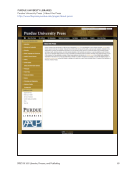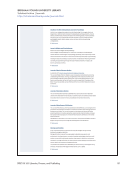55 SPEC Kit 357: Libraries, Presses, and Publishing
Please briefly describe the other reason/purpose. N=4
Annual statistics, staffing plan
Evaluate publishing costs.
Marketing to administration to draw awareness to the IR and local publishing activities.
Some involved with grant proposals.
36. Please briefly describe any changes to the library’s publishing activities that resulted from the
assessment outcome. N=15
Able to support graduate student assistantships.
Decided to create a university press.
Developed a new platform for access (Open Collections). Some consolidation of roles to address
operational and service gaps.
Expansion of scope of Library Publishing Services and hiring of new personnel.
Focused outputs/types of publications
Ingest of ETDs returned to us by ProQuest is now completely automated. Our IR is now providing
hosting services for the University Press of Colorado and archiving services for the Open Textbook
Library. Some staff have been cross trained. Prioritizing and tracking of tasks has been improved.
More investment in metadata services Increased efforts on print-on-demand offerings.
Need for a digital scholarship centre and added staffing support. Input received through the
restructuring process.
New staff positions created/changed.
None so far, other than to improve content within the publications.
Rewritten/renamed positions, became part of larger Digital Library Program. “Assessment”
activities ongoing.
Streamlined production and lowered costs.
We are currently engaged in this assessment. One small change already implemented is to move some
portion of journal hosting offsite.
We have developed a website with support help for journal editors.
We reduced the number of monographs published annually.
LESSONS LEARNED
37. Please briefly describe up to three lessons learned about providing publishing activities at your
library that may assist other libraries with their services. N=37
After early experimentation with a library press that was intended to focus on digital content while the
institutional press focused on print, we found the lines too blurry and a need for greater coordination
with the institutional press and/or more clearly defined and distinct missions in order to avoid
duplication of effort and potential competition.
An ad hoc approach to publishing can prove challenging without sufficient knowledgeable staff support.
We need to be prepared to answer questions from our faculty when they wish to publish a journal:
Please briefly describe the other reason/purpose. N=4
Annual statistics, staffing plan
Evaluate publishing costs.
Marketing to administration to draw awareness to the IR and local publishing activities.
Some involved with grant proposals.
36. Please briefly describe any changes to the library’s publishing activities that resulted from the
assessment outcome. N=15
Able to support graduate student assistantships.
Decided to create a university press.
Developed a new platform for access (Open Collections). Some consolidation of roles to address
operational and service gaps.
Expansion of scope of Library Publishing Services and hiring of new personnel.
Focused outputs/types of publications
Ingest of ETDs returned to us by ProQuest is now completely automated. Our IR is now providing
hosting services for the University Press of Colorado and archiving services for the Open Textbook
Library. Some staff have been cross trained. Prioritizing and tracking of tasks has been improved.
More investment in metadata services Increased efforts on print-on-demand offerings.
Need for a digital scholarship centre and added staffing support. Input received through the
restructuring process.
New staff positions created/changed.
None so far, other than to improve content within the publications.
Rewritten/renamed positions, became part of larger Digital Library Program. “Assessment”
activities ongoing.
Streamlined production and lowered costs.
We are currently engaged in this assessment. One small change already implemented is to move some
portion of journal hosting offsite.
We have developed a website with support help for journal editors.
We reduced the number of monographs published annually.
LESSONS LEARNED
37. Please briefly describe up to three lessons learned about providing publishing activities at your
library that may assist other libraries with their services. N=37
After early experimentation with a library press that was intended to focus on digital content while the
institutional press focused on print, we found the lines too blurry and a need for greater coordination
with the institutional press and/or more clearly defined and distinct missions in order to avoid
duplication of effort and potential competition.
An ad hoc approach to publishing can prove challenging without sufficient knowledgeable staff support.
We need to be prepared to answer questions from our faculty when they wish to publish a journal:



















































































































































































